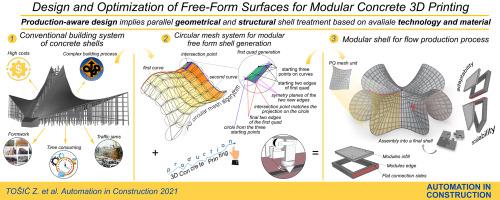Automation in Construction ( IF 9.6 ) Pub Date : 2022-07-06 , DOI: 10.1016/j.autcon.2022.104432 Zlata Tošić , Martin Friedrich Eichenauer , Egor Ivaniuk , Daniel Lordick , Sonja Krasić , Viktor Mechtcherine

|
Although they are very efficient structures, concrete shells have lost popularity due to the complexity of the traditional construction process using cast-in-place concrete. A key concept to overcome the labor-intensive formwork in situ is the segmentation of the shells into prefabricated parts. In order to avoid individual formworks during prefabrication as well, the authors rely on extrusion-based 3D printing of strain-hardening cement-based composite (SHCC). The goal is a highly automated, scalable, and adaptable flow-prefabrication of modules controlled by a holistic digital design process. Such the creation of modular free-form shell structures can be accelerated significantly, resulting in structures comparable with gridshells. Starting with the problem statement and the elaboration of the technology used, the main contribution of this research is the development of geometrical methods for modularization based on given production conditions. The challenge lies in the free-form geometry discretization with respect to the structural analysis and within the defined constraints such as planar quads, no edge torsion, and minimal material consumption. Methods of discrete differential geometry for circular PQ (planar quad) mesh generation are combined with Response Surface Methodology (RSM) for multi-objective optimization of the global parameterized shape. The results were illustrated in a study case where the geometrical and structural production parameters of starting and final shell are compared.
中文翻译:

用于模块化混凝土 3D 打印的自由曲面设计和优化
尽管它们是非常有效的结构,但由于使用现浇混凝土的传统施工过程的复杂性,混凝土外壳已经失去了普及。克服现场劳动密集型模板的一个关键概念是将外壳分割成预制部件。为了避免在预制过程中出现单独的模板,作者依赖于应变硬化水泥基复合材料 (SHCC) 的基于挤压的 3D 打印。目标是由整体数字设计过程控制的高度自动化、可扩展和适应性强的模块流预制。这种模块化自由形式壳结构的创建可以显着加速,从而产生与网格壳相当的结构。从问题陈述和所用技术的阐述开始,这项研究的主要贡献是开发了基于给定生产条件的模块化几何方法。挑战在于结构分析方面的自由形式几何离散化以及在定义的约束范围内,例如平面四边形、无边缘扭转和最小的材料消耗。用于圆形 PQ(平面四边形)网格生成的离散微分几何方法与响应面方法 (RSM) 相结合,用于全局参数化形状的多目标优化。结果在一个研究案例中得到说明,其中比较了起始和最终外壳的几何和结构生产参数。挑战在于结构分析方面的自由形式几何离散化以及在定义的约束范围内,例如平面四边形、无边缘扭转和最小的材料消耗。用于圆形 PQ(平面四边形)网格生成的离散微分几何方法与响应面方法 (RSM) 相结合,用于全局参数化形状的多目标优化。结果在一个研究案例中得到说明,其中比较了起始和最终外壳的几何和结构生产参数。挑战在于结构分析方面的自由形式几何离散化以及在定义的约束范围内,例如平面四边形、无边缘扭转和最小的材料消耗。用于圆形 PQ(平面四边形)网格生成的离散微分几何方法与响应面方法 (RSM) 相结合,用于全局参数化形状的多目标优化。结果在一个研究案例中得到说明,其中比较了起始和最终外壳的几何和结构生产参数。用于圆形 PQ(平面四边形)网格生成的离散微分几何方法与响应面方法 (RSM) 相结合,用于全局参数化形状的多目标优化。结果在一个研究案例中得到说明,其中比较了起始和最终外壳的几何和结构生产参数。用于圆形 PQ(平面四边形)网格生成的离散微分几何方法与响应面方法 (RSM) 相结合,用于全局参数化形状的多目标优化。结果在一个研究案例中得到说明,其中比较了起始和最终外壳的几何和结构生产参数。











































 京公网安备 11010802027423号
京公网安备 11010802027423号